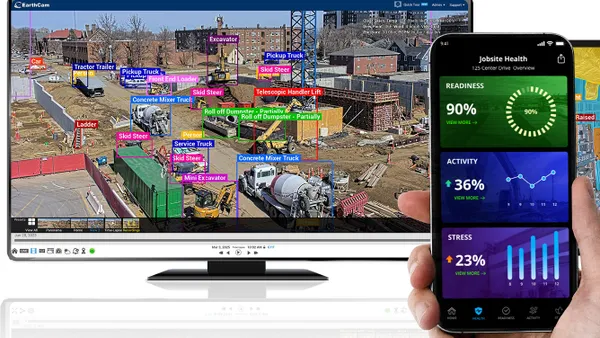Robots have continued to make inroads into the construction industry. Whether due to a lack of skilled labor, or simply new tech becoming commercially available, companies continue to market robots and drones to contractors as options to perform important tasks faster and more efficiently.
Here, Construction Dive looks at recent innovations in robotics that could potentially pick up extra slack or speed up jobsite work.
Husky A200
This small, four-wheeled robot could aid contractors by carrying tools and materials around the site. A group of engineers at the Fraunhofer Italia Innovation Engineering Center (IEC) in Bolzano, Italy, are working on a way to adapt the Husky A200 to do just that, according to New Atlas.
The goal is to connect the robot’s software with BIM and provide other functions for it to be able to navigate the jobsite. The robot will also have a “follow me” function that allows it to trail behind workers while carrying a load. Tests are being conducted indoors, but the plan is to continue to challenge the robot’s ability to handle rough outdoor terrain.
GE Tunneling Earthworm
A GE Research team in Niskayuna, New York, is developing a small tunneling robot that mimics an earthworm’s manner of moving underground. The innovation is part of a program initially intended to develop equipment that can tunnel quickly in military environments. The robot can squeeze into tight spaces, uses a muscle- and skeleton-like structure to move earth and go forward, and can work autonomously.
Although it is still being developed, the goal is for the robot to successfully dig a tunnel over 540 yards long at nearly 4 inches a second (500 meters at 10 centimeters a second).
Coffee Feet Robot
Researchers at the University of California San Diego have discovered a way to help commercially available robots move up to 40% faster on uneven terrain. By placing a membrane filled with coffee grounds on the feet of a robot, the scientists were able to achieve better operation over uneven terrain, an important factor for any construction robot.
The scientists attached the coffee-filled feet, along with a system designed to suck air out from between the coffee grounds, to a hexapod robot and tested its ability to walk on uneven surfaces, such as wood chips and pebbles. They found that the pressure pushing the coffee grounds together allowed for easier gripping before the robot leg lifted and the grounds loosen once again.
Boston Dynamics' robot dog
After months of pilot testing, Boston Dynamics’ Spot the robot dog is now commercially available at a cost of $74,5000.
Outfitted with image-capturing devices and laser scanners, Spot can patrol predetermined pathways through a jobsite and navigate difficult terrain. The machine is designed to reduce worker hours spent doing the same tasks repeatedly, while also providing frequent, up-to-date images of the as-built site.
Hadrian X bricklaying robot
The Hadrian X, a bricklaying robot, has surpassed its personal record and is now capable of laying 200 bricks in an hour, according to Popular Mechanics. Using scanners, the machine can tell exactly where the bricks should be placed, via a 3D rendering of the completed building.
For the time being, the robot still needs to prove it's faster than a human bricklayer, but in the future, it could help contractors meet demands during the skilled labor shortage.












